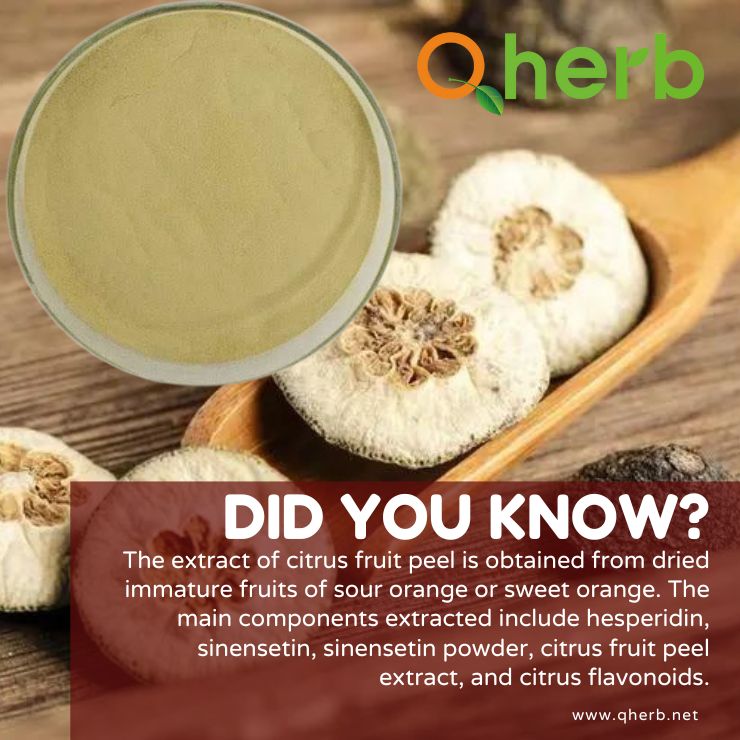What is Citrus Extract hesperidin?
Citrus Extract hesperidin is obtained from dried immature fruits of sour orange or sweet orange. The main components extracted include hesperidin, sinensetin, sinensetin powder, citrus fruit peel extract, and citrus flavonoids. Among them, hesperidin from citrus fruit peel extract has multiple effects such as maintaining normal vascular osmotic pressure, enhancing capillary toughness, reducing cholesterol, boosting immunity, and antibacterial, and antiviral properties.
Hesperidin, also known as dihydroflavonoid glycoside, has a molecular formula of C28H34O15 and a density of 1.65 g/cm3. It is a white or pale yellow crystalline powder, odorless, and tasteless. It is soluble in pyridine or dimethylformamide but insoluble in ethanol or water.
Produce methods:
- This product is present in the peel of citrus fruits such as lemon, orange, and pomelo. In the Citrus genus, citrus glycosides are abundant in the middle layer of the peel (white spongy tissue), while citrus peel glycosides are more abundant in thinner peel systems. This product is extracted from dried, mature orange peel. The dried orange peel is roughly crushed, and soaked in water at a ratio of 3-6 times the weight of the peel for about 0.5 hours to soften it. Then, 4-10% lime and 7-12 times the water are added, stirred evenly, and the pH value is checked. The pH value should be adjusted to 11.5-12 with lime or sodium hydroxide if necessary. After soaking for 1.5-2 hours, the mixture is centrifuged and filtered, and the residue is soaked again 5-7 times in the water with additional lime to adjust the pH to 11.5-12. After continued soaking and centrifugation until the solution is clear, the pH is adjusted to 5 with dilute hydrochloric acid and left to stand for 2 days. The precipitate is collected, washed with water to near neutrality, and then dried to obtain crude hesperidin. The crude product is dissolved in a mixture of 1% sodium hydroxide and 50% ethanol, filtered, and the filtrate is adjusted to pH 5 with dilute hydrochloric acid, left overnight, and the precipitate is collected. After washing once with 50% ethanol and then with water to near neutrality, it is dried at 70°C, crushed, and sieved to obtain hesperidin. The total yield of hesperidin from orange peel powder is 0.6-1.8%.
- Orange peel powder is mixed with water and lime, stirred evenly, and the pH is adjusted to 12-13 with 25% sodium hydroxide. After soaking for 10-12 hours, the liquid is filtered under pressure. The residue is discarded, and the pH is adjusted to 3-4 with concentrated hydrochloric acid, kept warm at 70°C for 0.5 hours. After cooling and settling, the precipitate is completely collected by filtration, washed with water to neutrality, and dried at 80°C to obtain crude hesperidin. Pure hesperidin can be obtained by recrystallization with methanol as the solvent.
Applications:
- It can be used as a nutritional fortifier.
- Hesperidin has vitamin P-like effects and can be used in skincare products to prevent frostbite. It has anti-inflammatory and antiviral properties and a certain antibacterial effect. When used in oral hygiene products, it can inhibit the formation of plaque and reduce bad breath. It can also prevent the peroxidation of skin cell lipids caused by ultraviolet radiation and can be used in sunscreen products.
Functions of hesperidin:
- As a vitamin-like drug, it can reduce the fragility of capillaries, protect capillaries, and prevent microvascular rupture and bleeding. It is used as an adjuvant therapy for hypertension.
- This product is a vitamin P-like drug used to enhance the toughness of capillaries. Methyl hesperidin, a derivative of hesperidin, is also a vitamin P-like drug and is listed in the Japanese Food Additive Standard Book. It is a medication for treating hypertension and myocardial infarction, used as a raw material in the pharmaceutical industry, and is a major component of the Chinese patent medicine Mai Tong.
In the fields of medical care, functional foods, food additives, and cosmetics:
Hesperidin can be used to synthesize a drug called diosmin. Meanwhile, hesperidin extracted from citrus fruit peel extract has multiple health benefits and is a good raw material for healthy food. In the cosmetics field, hesperidin extracted from citrus fruit peel extract can effectively prevent the erythema caused by the peroxidation of skin cell lipids by ultraviolet rays and can be used as an active ingredient in sunscreen and skincare products, facilitating the development of related products.
In the field of food:
When combined with citric acid, ascorbic acid, or phosphoric acid, hesperidin from citrus fruit peel extract can be used as a food additive to prevent lipid oxidation and spoilage. After hydrogenation, hesperidin has a sweetness 1000 times that of sucrose. It is widely used as a sweetener (masking agent) in the formulation of fruit juice, fruit wine, beverages, pastries, and pharmaceuticals, especially suitable for diabetic patients.

Comments
Post a Comment